#Fijian diaspora
Explore tagged Tumblr posts
Text
Lani and the Cumquat Adventures: Book Launch
Some projects are so dear to the heart, they feel magical when they are fulfilled. This is one of them. I first conceived of this book back in 2021. I wanted to tell the story of a little girl – I named her Lani – and her connection to her grandma. The grandma who was the first to hold her when she was born. The grandma who personified home, safety, love, and family for Lani. After drafting the…

View On WordPress
#children&039;s book#family#Fiji#Fijian diaspora#Fijian food#food security#Lani and the Cumquat Adventures#mighty girl
0 notes
Text
#cutlass magazine#indo caribbean#indian names#name meanings#indian diaspora#asian diaspora#etymology#surnames#indian surnames#indo caribbean surnames#indo fijian surnames#trinidad & tobago#guyana#anglicisation
0 notes
Text
for comparison: Fiji is about 37% Fiji-Indian, and about three quarters of them are hindu.
apparently Guyana is like 40% Indo-Guyanese and 30% Afro-Guyanese; it is religiously 25% Hindu which has to be some kind of record for the Americas. Gotta hurry up and secure that Indian military alliance.
#just to name another country with a LOT more Indian diaspora than people probably expect#i know about this one because Fijian Hindi came up in my linguistics class#demographics#guyana#fiji
17 notes
·
View notes
Text
The Rise of Fiji Rugby: A Nation’s Pride on the Global Stage
Early Roots of Rugby in Fiji
Rugby was introduced to Fiji by European settlers in the late 19th century, and by the early 20th century, it had become the most popular sport in the country. The first recorded rugby match in Fiji took place in 1884, and from there, the game quickly spread across the islands. Initially, the sport was dominated by expatriates and the Fijian elite, but over time, it became a game for everyone, with rugby becoming a key part of the nation’s identity.
The Fiji Rugby Union was founded in 1913, and the national team played its first international match against Samoa in 1924. From the beginning, Fiji's unique approach to rugby was evident. Their free-flowing style, characterized by quick passes, unpredictable running lines, and a strong emphasis on physicality, set them apart from the more structured approaches seen in other nations.
Fiji Rugby Sevens: A Global Force
Fiji’s dominance in Rugby Sevens is perhaps their most impressive achievement. Sevens is a faster, more open version of rugby, perfectly suited to the skills and attributes of Fijian players. fresh water coolers Supplier online With fewer players on the field and more space to exploit, Fijians have excelled with their speed, agility, and natural flair. The national Sevens team, known as the "Flying Fijians," has consistently been one of the top teams in the world.
Fiji won its first Hong Kong Sevens tournament in 1977, and this event became a cornerstone of the team's success. Over the years, they have won the Hong Kong tournament multiple times and have become one of the most successful teams in the World Rugby Sevens Series, winning numerous titles.
The pinnacle of Fiji’s Rugby Sevens success came at the 2016 Rio Olympics, where rugby returned to the Olympic stage for the first time since 1924. Fiji’s Sevens team dominated the competition, defeating Great Britain 43-7 in the final to win the gold medal. This was not only Fiji’s first-ever Olympic medal, but also a moment of immense national pride, with the team returning home to a hero's welcome.
In 2021, Fiji successfully defended their Olympic title at the Tokyo Olympics, further cementing their status as the kings of Rugby Sevens.
The Challenges and Triumphs of Fijian Rugby Union
While Rugby Sevens has brought Fiji global acclaim, the national Rugby Union team has also made significant strides. Fiji has competed in every Rugby World Cup since the tournament’s inception in 1987. Their best performances came in 1987 and 2007 when they reached the quarterfinals. Despite facing challenges such as limited financial resources, player migration, and administrative issues, Fiji continues to develop talented players who make their mark both domestically and in top-tier rugby leagues around the world.
One of Fiji’s major strengths is its rugby diaspora. Many Fijian players move overseas to play in professional leagues in New Zealand, Australia, England, and France. These players often return to represent the national team, bringing with them a wealth of experience from playing at the highest levels of the game. This has helped the national team remain competitive on the international stage.
The Future of Fijian Rugby
Looking ahead, Fiji rugby appears to be in a strong position. The inclusion of the Fijian Drua in the Super Rugby competition is a major development that will provide more opportunities for Fijian players to compete at an elite level while staying in the country. This will help retain talent and develop the next generation of Fijian rugby stars.

0 notes
Text
Post coup trauma – thirty-seven years on.
May 14th 1879, the Leonidas landed on Fiji’s shores with the first ‘batch’ of Indian indentured labourers, brought to toil on sugar plantations. After the Leonidas, 87 ships brought over 60, 000 indentured labourers to Fiji, whose children would become the first generation of an ethnic group known as Indo – Fijians.
May 14th 1987, Fiji: Colonel Sitiveni Rabuka was responsible for a racially fuelled coup in Fiji. After which many Indo Fijians including my parents emigrated to New Zealand.
In 2022, Sitiveni Rabuka was elected as the Prime Minister of Fiji. My mother felt uneasy about this. The trauma and undercurrents of 1987 has never gone away.
A lifetime has gone by since 1987, perhaps it is time to think about how past decisions now affect the diaspora?

Above: Attendees at the May 14th ‘Fiji Girmit Remembrance Day,’ Auckland. [Original image by Aaisha Khan]
vimeo
Audio DUR: 0.09 seconds.
Contact details of interviewee: [email protected]
0 notes
Text
Gallery visit: Carriageworks - Salote Tawale's I Remember You exhibition (12.1.24)
No Location (2021, bamboo, nylon rope, tarpaulin and found objects)




Description: "On a visit to the Fiji Museum in Suva at 10 years old, Tawale recalls seeing a scale model of a traditional Fijian watercraft known as a bilibili. A bilibili is used to transport people and goods downriver. It is made from readily available materials, which are disassembled and recycled at the end of a journey. As a child, Tawale imagined the vessel as a way to move between her home in Australia and family in Fiji. Originally presented as part of the 10th Asia Pacific Triennial of Contemporary Art at Queensland Art Gallery I Gallery of Modern Art, No Location is restaged at Carriageworks. Here, the artist reinterprets the established method of making a raft. Using the labour-intensive process of bundling and binding bamboo for the structure, Tawale distinctly incorporates tarps and ropes - everyday materials typical of her work - alongside personal items chosen for the artist's journey. In title and form, No Location embodies Tawale's experience of displacement; of being 'here' but also from 'there'."
The rest of the I Remember You Body of Work


















Description: "'I Remember You' uses memory to make sense of the world and our place within it. In this space, Salote Tawale presents a new work that sits in close relation to the industrial architecture of the building. With the gallery conceived as a 'memory bank', recycled cardboard masks hang from the yellow gantry crane, each marking a remembered moment, plywood cut-outs of people and plants are placed like theatrical set pieces; and a hibiscus floral pattern is loosely painted across the gallery wall. A partial replica of the artist's Fijian family home known as a vale - built on cinder blocks and clad with corrugated iron - stands complete with a clothesline out the back. Skid Row's 1989 hit 'I remember you' plays from the makeshift karaoke booth housed in the garage. With panels missing from the house, flowers fading out, and song lyrics misremembered, the installation is partially formed, materialising the fallibility of memory. Referencing her personal experiences of growing up in Australia as part of the Pacific diaspora through visual and aural triggers, Tawale constructs a space of belonging."
0 notes
Text
Personal afterword of my spoken word poetry book
as a songwriter and spoken word poet about being a displaced state side disconnected diaspora Asian native & QTIPOC
Personal afterword,
Let me first ask, reading the spoken word poetry book that I wrote as an orator and storyteller did you feel it, my mana? Did you feel it, my pain, agony, misery, anguish, grief, & mourning? Did you feel it, my anger, my hatred, loathing, wrath, fury, & rage? Did you feel it, my sorrow and torment? Did you feel my happiness, joy, & contentment? That is what I have been working on for a long time as a writer and artist. As a writer and creator who is a songwriter and spoken word poet I need people of color writers, editors, publishers, & artists as well as Indigenous (Indigenous to Turtle Island or Indigenous to Moana, Pasifika, or Oceania) writers, editors, publishers, & artists to help me create this spoken word poetry book. I wrote it as a storykeeper, orator, & storyteller to heal people who are displaced, to heal people who are disconnected, and to heal people who are diaspora. This is to Indigenous people especially those who are Indigenous Pasifika who are Polynesian, Micronesian, & Melanesian. This is for Polynesians who are Hawaiian, Tahitian, Samoan, Maori, or Tongan. This is for Melesians who are Fijian, Ni-Vanuatu, or Papuan. This is for Micronesians who are Marshallese, Chamorro, Pohnpeian, Kosraean, & Chuukese. We are separated and connected by land and sea. I wrote this as a storykeeper, orator, & storyteller for all of you. Those I consider to be whanau or chosen family. I want to perform this soon in Orange County and LA County in Southern California in Tongva Indigenous land in concert venues to people of color and or Indigenous audiences. That is once I find concert venues in So Cal or Southern California for spoken word poets and singers. As a writer and creator who is an storykeeper, orator, storyteller I want to someday perform the spoken word poetry book in Polynesia, Oceania, Moana, or Pasifika in Tahiti, New Zealand, Samoa, Hawaii, Tonga, Fiji, Vanuatu, Papua New Guinea, the Marshall Islands, & Guam to Polynesian, Melanesian, and Micronesian audiences. I also want to someday perform it to the protectors of Mauna Kea and offer it as my mana’o during an official ceremony. I want to go to Mauna Kea so I can perform to offer my mana'o to Mauna Kea as official ho'okupu or official gift during observance. I need Polynesian Indigenous Pasifika who are Samoan, Maori, Tahitian, Hawaiian, & Tongan. I need Micronesian Indigenous Pasifika who are Marshallese, Chamorro, Pohnpeian, Kosraean, & Chuukese. I need Melanesian Indigenous Pasifika who are Papuan, Fijian, & Ni-Vanuatu. I need people who are dancers, percussion drummers, choir, & orchestra to accompany me when I perform. I need Polynesian, Micronesian, & Melanesian translators to translate my spoken word poetry to Polynesian, Micronesian, & Melanesian Indigenous Pasifika audiences. I thought about this for a long time as a writer and creator. I have been writing this spoken word anthology book since jr. high in 7th grade. I am now in college. That is the only thing that will make sure the mana I have in mind when I perform happens. Since being a storykeeper, orator, and storyteller is something my family on my Chinese and Vietnamese side have been doing for generations. I don’t know what my French and Polynesian Tahitian Indigenous Pasifika ancestors did though. That is what I hope to find out by connecting and reconnecting. The audience though needs to be young adult to adult who are at least 18 or older since the topics the spoken word poetry book covers is displacement, being disconnected, being diaspora, cultural genocide, & generational traumas & those aren’t things children, preteens, & teenagers are mature enough to understand. It talks about many poc and Indigenous Pasifika issues such as inter-generational trauma, cultural genocide, colonialism, imperialism, neocolonialism and occupation, mental illnesses, suicide in the poc community and Indigenous community. It talks about many issues such as being displaced, being diaspora, displacement, being disconnected, decolonization, reconnecting, tattoo revival, & language revival. It talks about race, racial identity, racism, colorism, cultural identity, & anti native racism. It talks about the racial and cultural identity of being Southeast Asian Vietnamese or Kinh Indigenous of Vietnam person of color. It talks about the racial identity of being East Asian Chinese. It talks about the cultural identity of being Polynesian Tahitian Indigenous Pasifika. It talks about being a lighter skinned brown skinned brown native. It talks about having a darker skinned brown skinned brown native older brother. It talks about having a white coded white passing white native mother. It talks about Indigenous people being adopted out and being adopted by non native families such as my French and Polynesian Tahitian Indigenous Pasifika mother being adopted by a Vietnamese couple. It also talks about sex, gender, gender identity, sexuality, and sexual orientation in the poc community and Indigenous community before colonizers and imperialists imposed gender binary and sexual orientation binary on indigenous people. It talks about being mahu or maohi or in the middle an indigenous Pasifika third gender identity that is similar to two spirit a third gender identity of Indigenous people of Turtle Island. It talks about mahu or in the middle being a cultural responsibility and spiritual obligation. It talks about being a queer Indigenous Pasifika person of color. I am mahu or in the middle by Polynesian Indigenous gender fluidity and nonbinary genderfluid pansexual trans by western colonial binary. This is why I refer to myself throughout the spoken word poetry book as he/him, she/her, or they/them. It talks about being nonbinary genderfluid. It talks about being pansexual. It talks about being polyamorous. It also talks about poc/poc interracial relationships as a queer Indigenous person of color. As a writer and creator who is an author, comic book writer, screenwriter, songwriter, and spoken word poet I wanted to adapt Heart of Dragon Fire, Soul of Phoenix, & Blood of Fairy Ocean Water into an animated movie like Moana but for young adult to adult audiences that talks about being displaced, displacement, being diaspora, cultural genocide, being disconnected, connecting, and reconnecting. In that animated movie I would be the narrator. I would want to make it with a Polynesian Indigenous Pasifika cast and crew with Polynesian Indigenous: actors, voice actors, screenwriters, directors, & producers with a poc and or Indigenous network and studio. As a queer (mahu or maohi or in the middle by Polynesian Indigenous Pasifika standards or nonbinary genderfluid pansexual by western standards) Polynesian Indigenous Pasifika person of color writer and creator I want representation for all marginalized groups in media. As an author, comic book writer, & screenwriter I write a lot about lgbt, poc, disabled, and or Indigenous characters. I write a lot of comics, graphic novels, & books that are Indigenoius futurism and poc futurism. As an artist who is a spoken word poet and songwriter who’s an orator and storyteller I write a lot about race, racial identity, cultural identity, sex, gender identity, and sexual orientation.
Sincerely,
Christian Nguyen
I also go by my Vietnamese name Ngoc Dinh Nguyen or my chosen Polynesian name No’eau Aitonui Hoata/Heiani Mareva Hoata
Reviews for Heart of Fire Dragon, Soul of Flame Phoenix, & Sea Fairy Ocean Blood:
(This is where readers post their thoughts on the spoken word poetry book as a whole)
Other than that I’m also a writer and creator of bipoc and qtipoc futurism in books comics and graphic novels. The bipoc and qtipoc futurism project Chronicles of War the cyberpunk science fiction and magical high fantasy comic book or graphic novel series. It is about several queer and trans indigenous people of color or qtipoc main characters. One is a Asian Pasifika and Afro Latine native demigod and alien hybrid superhero in a cyberpunk world in the near and far future and the other is an Afro Asian native coded spellcaster swordfighter and gunslinger adventurer in a magical high fantasy world. Both of them are qtipoc and bipoc. There are other main characters in other precontact and post land back worlds. It has queer, trans, disabled, native Black, and or poc representation. It has indigenous and indigenous pasifika representation if you are interested in something like that. Rest of the info is on a google doc. Also needs email for google doc invite link.
0 notes
Photo




sugarcane scenes in Fiji (images taken 1930s - 1949).
in the 1990s Fiji produced over 4 million tonnes of sugarcane. today, production has declined to below 2 million tonnes tho sugarcane farming still provides a livelihood to approximately 15% of Fiji’s population. during the development of the industry some 35 sugar factories were established, but only 4 remain today.
all images retrieved from the Alexander Turnbull Library (New Zealand)
https://natlib.govt.nz/
0 notes
Text
I made this infographic as a sanity check, partially because a family member I spoke to could not believe that Black Americans were less than 15% of the U.S. population, until I pulled up U.S.census data to convince them. And partially to process the recent news about the Buffalo, NY shooting. Needless to say, I'm tired of living here, playing russian roulette with young, white 4channers with too much time and too many resources, enacting conspiracy-ridiculed hate crimes on innocent lives. The "white genocide" and "great replacement" conspiracy has been pinned on Jewish, Muslim, and non-white populations for decades. But even in the most saturated areas—even with a significant margin of error—we are so small and the gap is so, so wide.
Everything below is sourced directly from the U.S. Census Bureau and pertains to the most recent census. I understand other countries provide very different categories for racial and ethnic reporting.
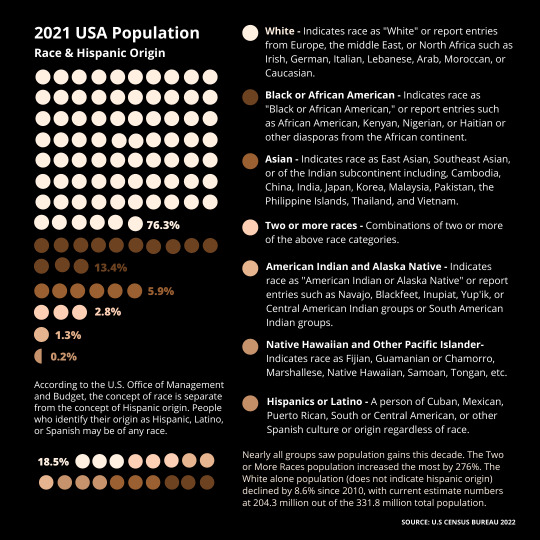
Transcript: A dot chart with various colored dots loosely indicating population percentage estimates.
2021 USA Population Race & Hispanic origin
White (76.3%) - Indicates race as "White" or report entries from Europe, the middle East, or North Africa such as Irish, German, Italian, Lebanese, Arab, Moroccan, or Caucasian.
Black or African American (13.4%) - Indicates race as "Black or African American," or report entries such as African American, Kenyan, Nigerian, or Haitian or other diasporas from the African continent.
Asian (5.9%)- Indicates race as East Asian, Southeast Asian, or of the Indian subcontinent including, Cambodia, China, India, Japan, Korea, Malaysia, Pakistan, the Philippine Islands, Thailand, and Vietnam.
Two or more races (2.8%) - Combinations of two or more of the above race categories.
American Indian and Alaska Native (1.3%) - Indicates race as "American Indian or Alaska Native" or report entries such as Navajo, Blackfeet, Inupiat, Yup'ik, or Central American Indian groups or South American Indian groups.
Native Hawaiian and Other Pacific Islander (0.2%) - Indicates race as Fijian, Guamanian or Chamorro, Marshallese, Native Hawaiian, Samoan, Tongan, etc.
Hispanics or Latino (18.5%) - A person of Cuban, Mexican, Puerto Rican, South or Central American, or other Spanish culture or origin regardless of race.
According to the U.S. Office of Management and Budget, the concept of race is separate from the concept of Hispanic origin. People who identify their origin as Hispanic, Latino, or Spanish may be of any race.
Nearly all groups saw population gains this decade. The Two or More Races population increased the most by 276%. The White alone population (does not indicate hispanic origin) declined by 8.6% since 2010, with current estimate numbers at 204.3 million out of the 331.8 million total population.
#current events#buffalo shooting#mass shooting#us politics#infographic#racial demographics#mine#hate crime#anti blackness#white supremacy#white genocide#the great replacement#death mention#ask to tag
127 notes
·
View notes
Text
This Is Why The Term “Desi” Is Problematic
The term is Desi is as expansive as it is limiting and here is why. The term Desi can take on different meanings depending where you reside. In the diasporic community it refers to the countries Pakistan, India, and Bangladesh. Back in the native homelands, the term Desi according to my understanding takes on a completely new meaning. Desi over there signifies that something is rustic, traditional, real. This can be compared to country culture in the U.S. I believe this is why Desi Ghee is termed Desi Ghee because traditionally the butter is churned.
Here is why I find the term Desi confusing and even inappropriate. Even though the term Desi in the diasporic community is meant to bring us all together, it also signifies what we are not, the same. Traditionally, South Asians have always identified themselves with their ethnicities and the regions they belong to not internationally recognized borders. i.e. Punjabi belongs to undivided Punjab, Bengali refers to someone who is from The Bengal. The ‘i’ denotes the relationship between the word preceding it. Etymologically speaking the terms Desh in Sanskrit meant land, over time the meaning changed and got to the point where we are now, at least in the diaspora.
Ethnicities in South Asia do not respect borders and can even “spill over” into other countries. Balochis are both present in Pakistan and Iran, the Pashtuns are present in both Pakistan and Afghanistan, Punjabis are both present in India and Pakistan, Bengalis are present in India and in Bangladesh, Tamils are present in India and Sri Lanka, and lastly Biharis are present in India and in Nepal. Now if you’re wondering about Kashmir, I will discuss that later.
Now this is where the term Desi starts to get very vague. If being Desi refers to Pakistan, India, and Bangladesh, what about the ethnicities that are not in those countries? All of these above mentioned ethnicities that spill over in Afghanistan and Nepal share historical, genetic, linguistic, and cultural ties with the other half that are part of the Desi countries. Are they suddenly not included even though they’re the same people? Because they happen to be outside of these borders? What about those with dual identities like Indo-Tibetans. For those who do not know, India has a whole government in-exile, namely the Tibetan government. Surely the Tibetan governemnt is IN INDIA and Indo-tibetans are as Indian as anybody else, but Tibet does not belong to the three Desi countries.
Now what about Indo-Caribbeans, Indo-Africans, and Indo-Fijians? Does the term Desi apply to them as well? Because ironically Desi took on a new meaning because of the diaspora. They are part of the ‘Indian’ diaspora removed 200 years from their native homelands of mainly Bihar and Uttar Pradesh. We can expand this to the Romani people as well who are present in Eastern Europe. Their lineage is said to trace back to Punjab a thousand years. All of these groups are culturally, linguistically, and genetically still tied to Undivided-India even though they go generations back. How many generations does it take before the term does not apply to someone? because Indo-Caribbeans, Indo-Fijians, Indo-Africans, and the Romani people are not considered to be Desi by the Desi community themselves even though they are part of the diaspora.
This is why I believe that the term Desi actually limits itself to Northern-India, and more specifically Punjabis. This is because Punjabis from both India and Pakistan dominate the Diasporic community in both visibility and in representation. When you go to a Pakistani or Indian restaurant in The West, the cuisine is obviously Punjabi. It rarely serves dishes from other regions. When people think of Indian music, they think of Bhangra, a Punjabi folk tradition. When people think about Bollywood, they might think of the colorful clothes, music, dances, or actors, all which is focus on Northern Indian and Pakistani Indic culture in general. The Punjabis dominate the Bollywood industry and thus have left their mark on the Industry and the global audience that have inadvertently started associating “Indian” culture with Punjabi culture as a whole.
On to Kashmir. if the term Desi in the diasporic community refers to people belonging to Pakistan, India, and Bangladesh that were once part of Undivided-India, what about people who have always sought an identity separate from these countries? What about new South-Asian countries? To my understanding Kashmiris in general do not want to affiliate themselves with neither Pakistan nor India because they have always demanded a new country which is still in limbo. The Kashmir situation is rather unique in that it was actually proposed to be a self-governing nation free of Pakistan and India. Would Kashmiris identify themselves as Desi? Does this mean that the term Desi is as fluid as its ethnicities that spill into Non-Desi borders?
And this is why I find the term Desi problematic.
#southasia#indian#pakistani#bangladesh#desi#nepal#nepali#afghan#indianculture#desi tag#brown#indocaribbean#romani#african#history#southasian#bengali#bollywood
111 notes
·
View notes
Text
Endangered Languages Challenge: Takuu
Endangered Languages Challenge — round 1, post 6: Takuu
name(s) of the language Gagana Takuu, Takuu, Mortlock, Taku, Tau, Tauu
genealogical affiliation Malayo-Polynesian > Central-Eastern Malayo-Polynesian >> Eastern Malayo-Polynesian >>> Oceanic >>>> Central Pacific linkage >>>>> Tokelau-Fijian >>>>>> Polynesian >>>>>>> Nuclear Polynesian >>>>>>>> Northern Outlier Polynesian-East Polynesian >>>>>>>>> Solomons Northern Outlier Polynesian-East Polynesian >>>>>>>>>> Central Northern Outlier Polynesian-East Polynesian >>>>>>>>>>> Central Northern Outlier Polynesian >>>>>>>>>>>> Takuuic >>>>>>>>>>>>> Takuu
location of the language Mortlock Islands, Papua New Guinea (not to be confused with the atolls of the same name in Micronesia!)

number of speakers 1,750 (2003 SIL), decreasing. 350 monolinguals; the number was judged stable in 2003; vertical transmission may soon be interrupted due to emigration of younger generations
endangerment situation While Takuu is not presently considered seriously endangered as it is vigorously spoken throughout the island, it is becoming increasingly threatened as an ever greater number of the island's inhabitants are leaving the island because of economic hardships and the impact of climate change and rising sea levels. Many of Takuu's younger generations living abroad no longer use Takuu in everyday conversation while the population of the island itself is becoming more and more depleted. Takuu activist Raroteone Tefuarani said that she was shocked when seeing the rapid loss of language and cultural identity among the Takuu population which had been resettled in Buka, Bougainville in 2012. As of 2016 there are only estimated to be a few hundred residents permanently living on Takuu. (Radio NZ) The language is currently considered vital but that may well change within a decade, depending on outside factors like sea level rise.
speaker community [M]ost of the population lives on the tiny island of Nukutoa, in homes built on the water's edge.No part of the island group protrudes higher than two metres above sea level, with most being less than one metre. Both climate change and the movement of tectonic plates are touted as culprits for the encroaching tides. [...] Slowly submerged by swelling tides, years of uncertainty surrounding the atoll's future has led to a gradual decline in population — only about 300 people remain at Takuu Atoll.Dr Richard Moyle of the Queensland Conservatorium Research Centre has spent years documenting and compiling their language and music. "There's only about half as many people there as there were when I was there last, about six years ago" Dr Moyle said. (ABC.net.au)
language breakdown Structural collapse has not yet been reported. With the ongoing exodus of speakers, the community will sooner or later fragment and assimilate into diaspora surroundings.
official / legal status The language is taught in primary schools.
documentation status Takuu has been described linguistically (grammar, dictionary), and there are a few text (poem) collections and bible translation efforts; apparently there is no full-fledged documentation archive or corpus
Sources & Resources:
https://glottolog.org/resource/languoid/id/taku1257
https://www.ethnologue.com/18/language/nho/
http://www.language-archives.org/language/nho
https://en.wikipedia.org/wiki/Takuu_language
https://www.abc.net.au/news/2016-09-24/takuu-atoll-at-risk-from-climate-change/7872116
http://www.radionz.co.nz/international/pacific-news/314587/the-bougainville-outlier-whose-people-are-leaving
#endangeredlanguageschallenge#endangered languages#language maintenance#language documentation#climate change
26 notes
·
View notes
Text
Going back to visit Fiji is on my list of things to do this year, I hardly have any family there since most of them migrated to NZ or Canada but I just don’t want to feel like a tourist in a country that I was born in. As I am a Fijian-Indian diaspora I’ve become disconnected to my cultural & ancestral identity, and I feel real shitty about it.
1 note
·
View note
Text
Fijians in Canada welcome direct flights
Fijians in Canada welcome direct flights
The Fijian diaspora living in Vancouver, Canada, have welcomed Fiji Airways’ direct flight, which will make it easier for them to travel home. The national airline began direct flights to Canada a week ago and has since transported hundreds of visitors and locals to and from the country. Former Fiji national Umendra Singh says he constantly returns home to visit family, but the new direct…

View On WordPress
0 notes
Text
RESEARCH LECTURE
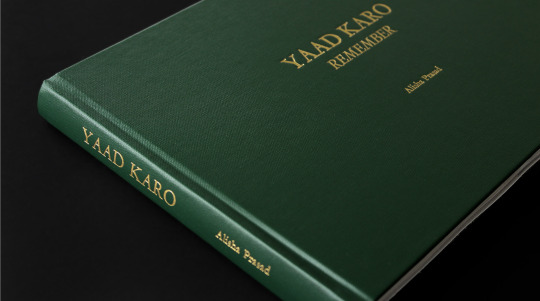
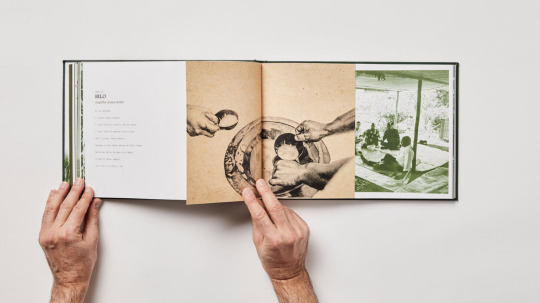
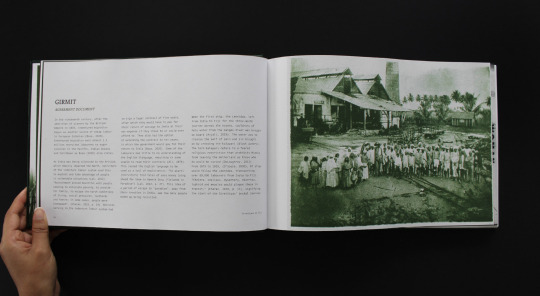
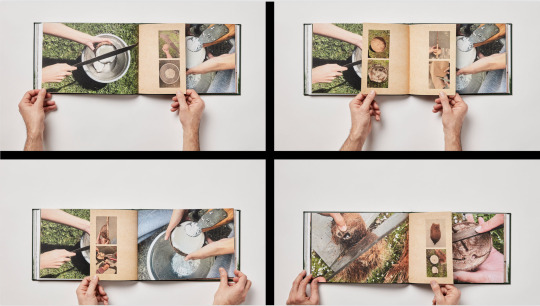
The work of Alisha Prasad - Yaad Karo
This was one of the examples shown in the Monday lecture. This was design research and process insights and inspirations from BEST Awards nominated Communication Design Alumni: Alisha Prasad. She talked about making connections between research, context and practice. This was super insightful to see as her research practise was so super thoughtful as well as close to her heart. I this the mix of image making from phtoographs, the cut outs and the use of different printed materials made the publication tie together with the topic also.
Further research on this project:
Description copied from Best Award website:
Yaad Karo is a publication that tells the stories and lived experiences through significant objects of Indo-Fijian Girmitiyas (Fiji Hindi word for Indentured Labourers brought from India to Fiji by British colonial forces). As a descendant of Girmitiya, this publication is about connecting through my design to my community, history, and ancestors, and aims to contribute to the collective understanding of the history of Indo-Fijian indentured labour.
Girmit was an indentured labour system that started in 1833 as an alternative source of cheap labour to European colonies after the abolition of slavery. Up until 1916, over 60,500 indentured labourers from India were transported to Fiji to work on sugarcane plantations. On the plantations, the Girmitiyas were faced with an onslaught of gruelling circumstances and harsh conditions but through this they showed strength, courage and resilience.
Yaad Karo inquires and explores how object making can convey oral histories and personal stories of not only my family but my ancestors as well. I researched, designed, and made the objects through the methodological frameworks of embodied cultural practice, oral histories and being an insider researcher.
The work showcases the journey of the Girmityas over the kala pani (black water), their lives on sugarcane plantations and what got them through the exhausting labour required of them. Due to erasure of Indo-Fijian history, engaging with these cultural objects through researching and making is one of the only ways in which I can connect to my ancestors and histories. For young Indo-Fijians who are a part of the diaspora, who may not have a deep comprehension of their own ancestral history, this publication acts as an entry point into greater discussions and learning.
Yaad Karo in Fiji Hindi means to remember, it is an act. The title is a call to action for the Indo-Fijian community to remember our histories which have all but been erased. Yaad Karo is calling on us, descendants of indentured labour, to remember and engage with our collective past.
https://bestawards.co.nz/graphic/student-graphics/aut-art-design/yaad-karo/
0 notes
Text
Presence of an Absence
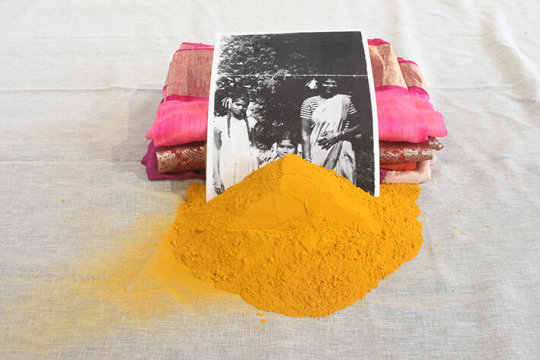
Shivanjani Lal is twice displaced Fijian Indian Australian artist. She uses found objects, film, performance, and ritual in her work. Her writing examines the histories that led her family from India to Fiji and later to Australia as well as the diaspora of indentured labour in the Indian and Pacific Oceans. She derives inspiration for her installations, films, and photos from her own loss resulting from the dispersion of her ancestors.
Her ongoing artistic endeavours consistently pay tribute to the tragedy suffered by her family. Shivanjani recreates places associated with her generational suffering in her piece "Yaad Karo" utilising personal family photos and artefacts. The materials and containers used in this exhibit provide the sensation of being a part of a ceremony to honour the first-generation ancestors of her family. By serving as a reminder of the enslaved labour used throughout the colonial era, they are being used to study the temporal aspect of the artefacts. This piece's presentation and site-specificity piqued my interest the most. It inspired me to explore different options.
0 notes
Text
Fiji congratulates India on 76th year of independence – FBC News
Fiji congratulates India on 76th year of independence – FBC News
[Source: Fijian Government / Facebook] India marked 76 years since the country became independent and ended almost 200 years of British colonial rule. Last night, the Indian High Commission celebrated with a reception at the Grand Pacific Hotel. It was attended by the Prime Minister, Voreqe Bainimarama, government ministers, parliamentarians, dignitaries, and members of the Indian diaspora…

View On WordPress
0 notes